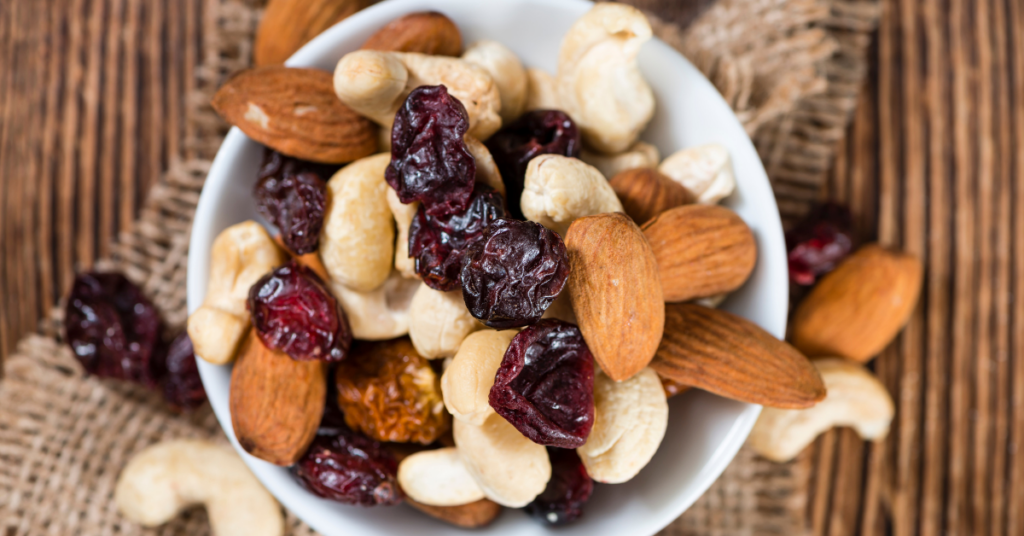
Article at a Glance:
- Macronutrients are essential nutrients for your health, energy, basic physiology, and sustaining life.
- They include protein, fats, and carbohydrates.
- All humans need a mix of all three macronutrients in their diet. For the most health benefits, macronutrients should primarily come from whole and minimally processed foods versus ultra-processed and refined foods.
Nutrition can easily become confusing, given the sheer amount of information available to us— which is often conflicting. While personalized nutrition is trendy, it’s important to first have a solid understanding of the basics. This starts with the macronutrients: protein, fat, and carbohydrates.
Macronutrients are the three main components of your diet, and they are essential to provide energy, fuel basic physiology, and sustain life. Everyone needs them and, thankfully, they are abundant in foods.
Let’s take a closer look at each of the macronutrients—or “macros”—including what they do in the body, how much you need, and where to find them.
Protein
Protein gets a lot of airtime because there’s a perception that it’s the most important macronutrient. That’s why you see “with added protein” on just about everything now, from your favorite afternoon energy bar to your morning oatmeal packet.
Protein is essential, yes, but you probably don’t need quite as much as you’ve been led to believe—and it’s important to ensure you’re getting it from healthy, high-quality sources.
What is it?
Protein is a macronutrient made up of “building blocks” called amino acids. It plays a key role in building and repairing tissues like muscles, skin, and organs, and it’s essential for enzymes, hormones, and immune function.
Where do I find it?
Protein is found in both animal and plant foods. Animal sources include meat, poultry, fish, eggs, and dairy products like cheese and yogurt. Plant-based sources include beans, peas, lentils, tofu, tempeh, edamame, nuts, seeds, seitan, some whole grains, and even vegetables (like broccoli!) in small amounts.
Note that protein from plant foods comes packaged in fiber, vitamins, minerals, and antioxidants. Animal sources of protein don’t provide fiber and do contribute saturated and trans fats to your diet.
Why do I need it?
You need protein to help your body grow, heal, and maintain muscle mass. It also helps regulate hormones, support your immune system, and keep you feeling full and satisfied after meals.
How much protein do I need?
The general consensus is that most healthy adults need a minimum of around 0.8 grams of protein per kilogram of body weight (or about 0.36 grams per pound). For example, a 150-pound person would need around 54 grams per day.
However, needs may be higher for people who are very active, pregnant, recovering from illness, or over age 65 (to help prevent age-related lean muscle mass loss).
Fat
Fat was feared for a long time (and probably still is, to some degree), which led to the tidal wave of low-fat and fat-free food products entering the market. Spoiler alert: These products were often high in added sugars to make up for the flavor, instead—and not automatically healthier.
The truth is that fat as a whole isn’t bad—it’s essential. However, it’s important to choose unsaturated fats over saturated fats as much as possible, as an excessive amount of the latter is associated with a higher risk of overweight and obesity, cardiovascular issues, and insulin resistance.
What is it?
Fat is a macronutrient that provides a concentrated source of energy and helps your body absorb fat-soluble vitamins (A, D, E, and K). It also plays a role in hormone production, brain health, and cell structure.
Where do I find it?
Healthy fats are found in foods like avocados, nuts, seeds, olives, and oils (like olive, avocado, or flaxseed oil). You’ll also find fats in animal products such as dairy, meat, and fatty fish like salmon. Note that tropical oils like coconut and palm oil are plant-based but are also very high in saturated fat.
Why do I need it?
Your body needs fat for energy, to cushion organs, regulate body temperature, and support brain and nerve function. Fats also help you stay full and satisfied after eating.
How much fat do I need?
Fat should make up about 20–35% of your total daily calories. For someone eating 2,000 calories per day, that’s around 44–78 grams of fat. Focus on getting most of your fat from unsaturated sources (like plants and fish) rather than saturated or trans fats.
Foods that contain fats are generally calorie-dense, meaning they provide a solid amount of energy (and fat) per serving—meaning, a little bit generally goes a long way toward meeting daily dietary fat requirements.
Carbohydrates
Move over, low-carb diets, you have no place here. Did you know that carbohydrates are your body’s primary source of energy? That’s right—when you eat carbs, they’re digested into glucose (sugar) molecules, which are then transported (by way of insulin) into your muscles to where they’re needed or stored for later use.
What’s most important about carbs is that, like fats and proteins, they’re not all created equally. Getting your carbs primarily from fiber-containing foods offers more health benefits than getting them from ultra-processed and refined foods.
What are they?
Carbohydrates are the body’s main source of energy. They’re broken down into glucose (sugar), which fuels your brain, muscles, and other tissues.
Where do I find them?
Carbs are found in fruits, vegetables, grains, legumes, dairy, and foods made with added sugar (though this last one isn’t the healthiest option). Whole-food sources like brown rice, oats, beans, and sweet potatoes are some of the most nutrient-dense, stick-to-your-gut, energizing options.
Why do I need them?
Carbs fuel your daily activities, support brain and nervous system function, and provide fiber, which helps with digestion and blood sugar control.
How many carbohydrates do I need?
The Dietary Guidelines recommend that 45–65% of your daily calories come from carbohydrates. For someone eating 2,000 calories per day, that’s about 225–325 grams of carbs. Emphasize complex carbs and fiber-rich foods over refined sugars and processed snacks.
Macronutrients: The Bottom Line
Most people don’t need to spend their time carefully counting macros, but it is important to know where yours are coming from and prioritize getting them from a balance of healthy food choices. Eating a diet that includes mostly whole and minimally processed foods is the simplest way to meet your macronutrient needs and fuel your body well.
If you’re looking for a convenient source of high-quality protein, whether to support a busy lifestyle or supplement your gym routine, consider the LiveComplete plant protein line.
Sources:
- Venn BJ. Macronutrients and Human Health for the 21st Century. Nutrients. 2020 Aug 7;12(8):2363. doi: 10.3390/nu12082363. PMID: 32784664; PMCID: PMC7468865. https://pmc.ncbi.nlm.nih.gov/articles/PMC7468865/
- Carreiro AL, Dhillon J, Gordon S, Higgins KA, Jacobs AG, McArthur BM, Redan BW, Rivera RL, Schmidt LR, Mattes RD. The Macronutrients, Appetite, and Energy Intake. Annu Rev Nutr. 2016 Jul 17;36:73-103. doi: 10.1146/annurev-nutr-121415-112624. PMID: 27431364; PMCID: PMC4960974. https://pubmed.ncbi.nlm.nih.gov/27431364/
- Richter M, Baerlocher K, Bauer JM, Elmadfa I, Heseker H, Leschik-Bonnet E, Stangl G, Volkert D, Stehle P; on behalf of the German Nutrition Society (DGE). Revised Reference Values for the Intake of Protein. Ann Nutr Metab. 2019;74(3):242-250. doi: 10.1159/000499374. Epub 2019 Mar 22. PMID: 30904906; PMCID: PMC6492513. https://pmc.ncbi.nlm.nih.gov/articles/PMC6492513/
- Lonnie M, Hooker E, Brunstrom JM, Corfe BM, Green MA, Watson AW, Williams EA, Stevenson EJ, Penson S, Johnstone AM. Protein for Life: Review of Optimal Protein Intake, Sustainable Dietary Sources and the Effect on Appetite in Ageing Adults. Nutrients. 2018 Mar 16;10(3):360. doi: 10.3390/nu10030360. PMID: 29547523; PMCID: PMC5872778. https://pmc.ncbi.nlm.nih.gov/articles/PMC5872778/
- Maki KC, Dicklin MR, Kirkpatrick CF. Saturated fats and cardiovascular health: Current evidence and controversies. J Clin Lipidol. 2021 Nov-Dec;15(6):765-772. doi: 10.1016/j.jacl.2021.09.049. Epub 2021 Oct 1. PMID: 34649831. https://pubmed.ncbi.nlm.nih.gov/34649831/
- von Frankenberg AD, Marina A, Song X, Callahan HS, Kratz M, Utzschneider KM. A high-fat, high-saturated fat diet decreases insulin sensitivity without changing intra-abdominal fat in weight-stable overweight and obese adults. Eur J Nutr. 2017 Feb;56(1):431-443. doi: 10.1007/s00394-015-1108-6. Epub 2015 Nov 28. PMID: 26615402; PMCID: PMC5291812. https://pubmed.ncbi.nlm.nih.gov/26615402/
- USDA. Dietary Guidelines for Americans, 2020-2025. https://www.dietaryguidelines.gov/sites/default/files/2021-03/Dietary_Guidelines_for_Americans-2020-2025.pdf
- Holesh JE, Aslam S, Martin A. Physiology, Carbohydrates. 2023 May 12. In: StatPearls [Internet]. Treasure Island (FL): StatPearls Publishing; 2025 Jan–. PMID: 29083823. https://pubmed.ncbi.nlm.nih.gov/29083823/



